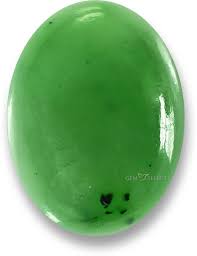What is commonly known as jade can actually be one of two minerals, jadite or nephrite. Jade has been used since prehistoric times, when it was made into weapons and tools. Another name for nephrite is 'kidney stone', as both jadite and nephrite were traditionally thought to be capable of easing kidney problems. Indeed, the word nephrite comes from the Greek nephros, meaning kidney, while jadite is believed to come from the ancient Spanish phrase, piedra de ijada, which means 'stone of the flank' and refers to the ancient practice of tying a piece of jade to your side to ease kidney pain.
Although people usually think of China and East Asia when talking about jade, it has been equally popular in Central America for thousands of years. Before the coming of the conquistadors, jade was considered more precious than gold. The Mayans used jade in their jewellery and carvings and placed it in or near dead bodies of those of highest rank. In both Central America and Egypt, jade was thought to symbolise the heart.
Today, jade remains a popular stone in many cultures. In China and South East Asia, jade is particularly popular when worn as jewellery because it is believed to ensure fortune, prosperity and longevity. One custom is to give a bracelet of jade to a newborn child.
The Chinese have always adored jade as their most precious gemstone. It was known as the 'Emperor's stone' and connected with power and authority - the apple or emerald-green varieties being considered most valuable.
In the East, jade was considered Yang in nature and believed to be either the solidified essence of pure mountain water or solidified dragon's semen. The crystal was thought to demonstrate the five cardinal virtues of chastity, courage, justice, modesty and wisdom and was sacred to Kwan Yin, goddess of compassion, and to Buddha.

Storm Stone
In Mexico, jade fell under the governance of Chalchiuhticue, the goddess of the storm whose name means 'precious green lady'. The Aztecs believed the Chalchiuhticue's special stone could be found wherever lightening struck the ground.
Healing with Jade
Jade is believed to be a powerful healing stone the improves physical health and protects its owner from disease and bad fortune. It is also traditionally believed to bring luck, status, fame and material wealth, and if considered a luck stone to have at the beginning of a new project.
Jade has a long association with dreams. Shamans have used this stone to help understand dreams and visions, and it has been said that jade can help manifest any desired object or wish - making dreams come true. However, its properties are thought to be balancing as well as providing abundance. In this way it is believed to give a clear vision more of what is needed than desired, so that we can live in prosperity without greed.
Today, jade is sometimes recommended to help us remember dreams and connect to the true meaning of the messages that may be within them. Jade is also said to help us connect to our true potential, giving us the strength to pursue our purpose with success.
The green colour of jade indicated that it resonates with the Heart Chakra and carries the vibration of deep peace and harmony. It is believed to bring deep peace even to the transition from life into death.
Using your Jade
Jade is believed to come from a multitude of ancient mythical sources and is thought to provide amazing fortitude for your mind, body and spirit.
Kidney problems
Jade has been used for many centuries to help treat people with kidney problems.

An amulet made from a piece of jadeite or nephrite may be carried in a trouser or skirt pocket a all times, so it's close to the kidneys and its influence can have a continuous effect to help ease problems.
At night, put a piece of jade by a window, where it can be bathed in moonlight.
On the full moon visualise silver lunar energy descending and filling the stone, and say "beautiful Moon governing the tides, charge this jade that with me bides".
Wealth crystal
Jade has a long history of being used to attract wealth and prosperity due to its associations with royalty. Chinese businessmen have long used jade to attract new business and promote worthy causes and ventures.
Put a piece of jade on your desk in your workplace. Not only will the stone help to attract wealth, it will promote calm and harmony - an ideal atmosphere for meetings and discussions.
To get the best results from your jade wealth talisman, anoint it with morning dew that you have gathered before any scheduled meetings you might have. This will encourage fresh outlooks and beginnings with the energy of the new day that is held within the dew.
Divine liquor
An old recipe from Chinese alchemy records how to make the 'divine liquor of jade'. It's created by taking equal parts of green jade, rice and morning dew, and boiling them in a copper pot. The liquid would then be filtered off and a cup drunk every day.
The divine liquid was believed to strengthen the muscles and make them supple, harden the bones, calm the mind enrich the flesh and purify the blood.

Consistent consumption of the divine liquor over a prolonged period was believed to increase tolerance to heat and cold, and reduce the need for other food or drink.
Promoting love
In China, some lovers still give each other carved jade butterflies as love tokens. Jade has been called the 'concentrated essence of love', and the purity, endurance and serenity it brings are all qualities that help make a successful long-lasting relationship.
When you are expecting your lover over for a visit, take your piece of jade and strike it very lightly twice with a small piece of metal, like the end of a teaspoon.
This sound jades makes establishes harmony, which will help to create a balance in all of your relationships.
